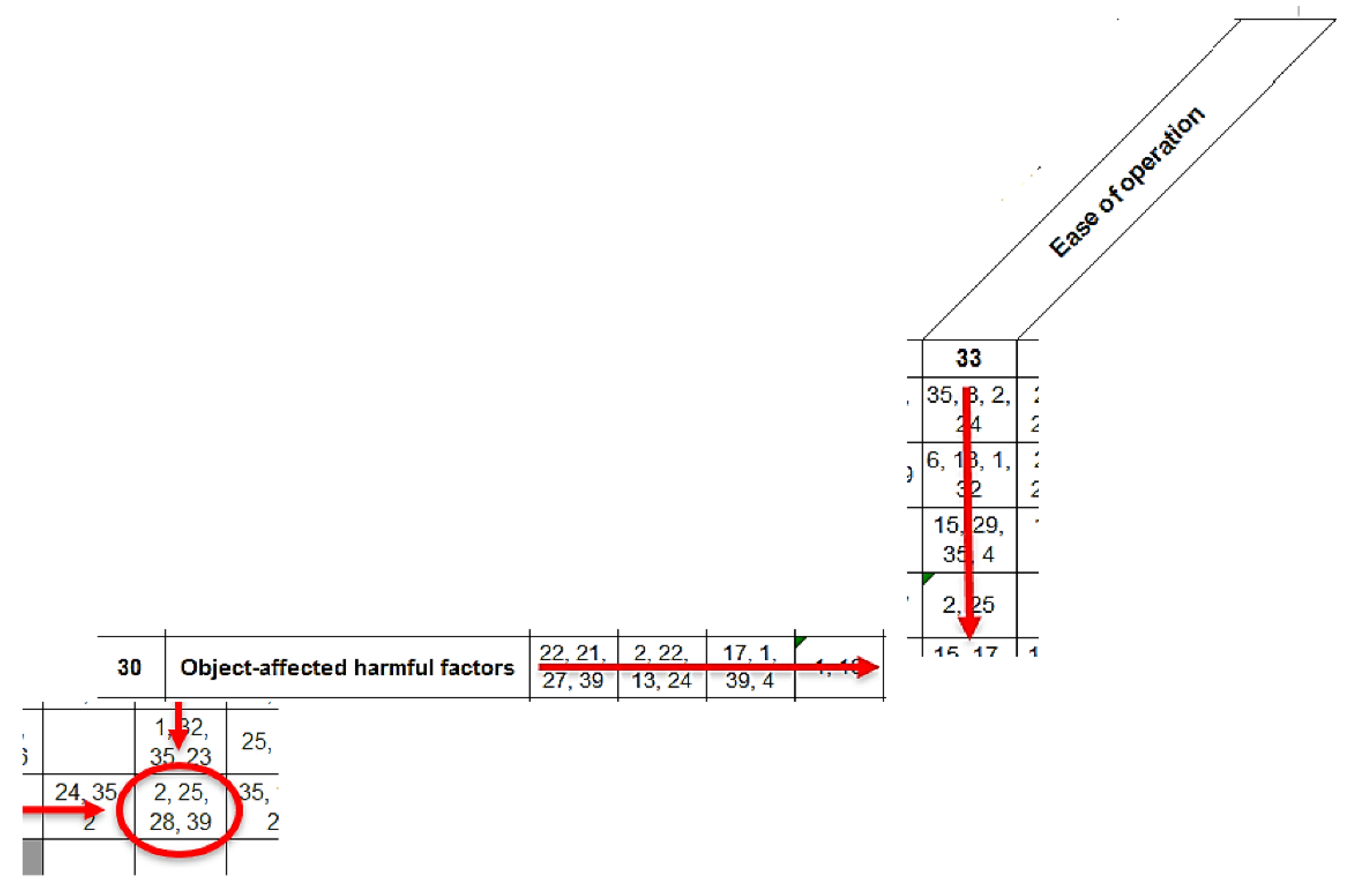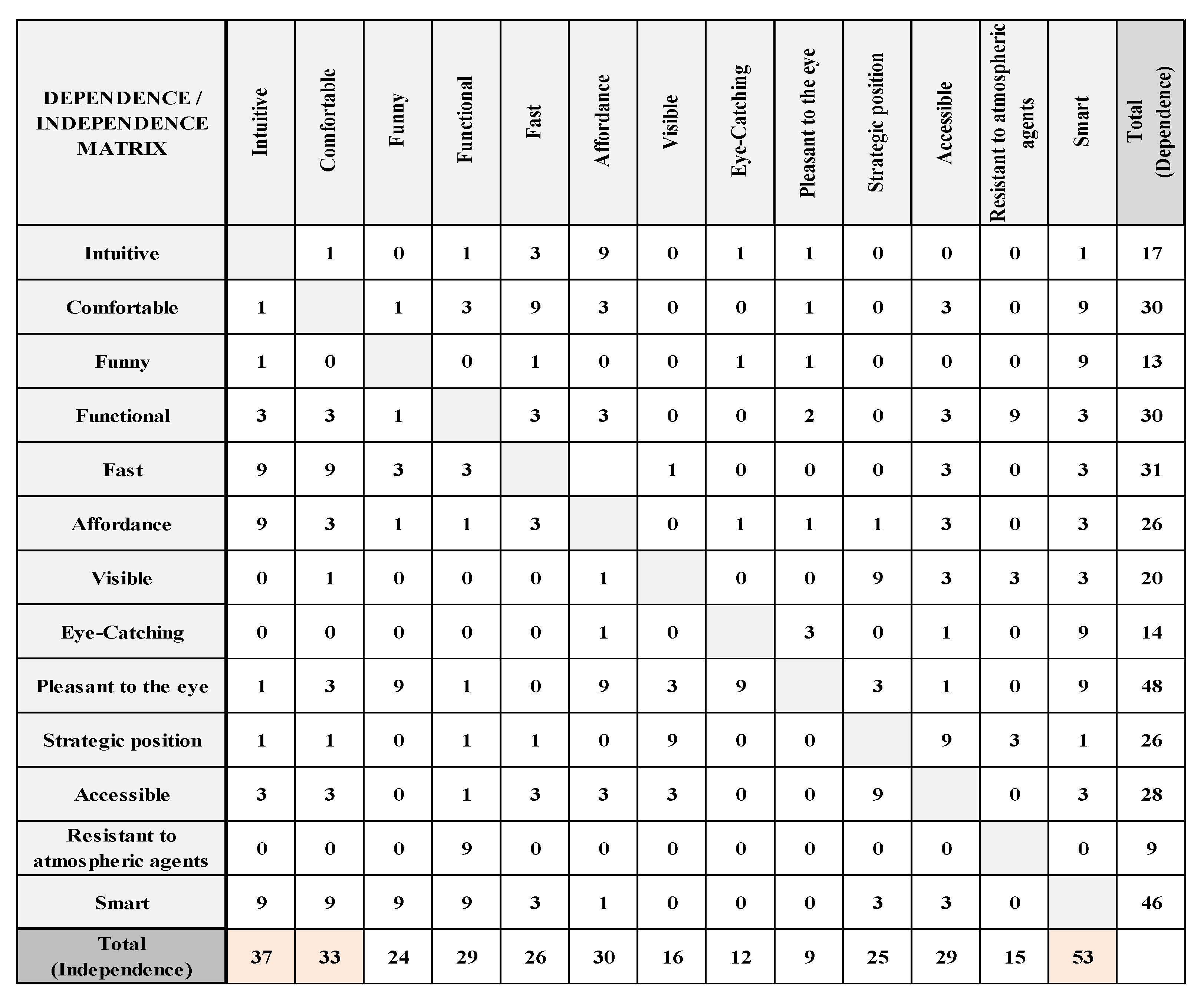Design for Six Sigma and TRIZ for Inventive Design Applied to Recycle Cigarette Butts
Abstract
:1. Introduction
2. Materials and Methods
Design for Six Sigma: DMADV
- Define. The client’s wants and demands are gathered during the initial stage. It is crucial to pay attention to the issues customers face when interacting with a certain product that is already on the market or which novel products could meet their needs, both expressed and unexpressed. It is always in this phase that the TRIZ methodology can be applied to solve any inventive problems.
- 2.
- 3.
- Analyze. The design of the new product is developed using the essential features discovered in the second phase. In order to do this, a Benchmarking analysis is conducted, allowing researchers to examine rival products’ designs that are similar to the one in question.
- 4.
- Design. We move forward with the design of the new product utilizing the appropriate tools based on the outcomes of the analysis phase. The information gathered from the preceding points must all be taken into account in this phase, and every effort must be made to respect them as much as possible.
- 5.
- Validate. In this final step, it is categorically declared that the finished product supports the anticipated outcomes. It is feasible to create prototypes that can be tested to see if the product meets the necessary criteria [29].
3. Results
3.1. Problem Definition
3.1.1. Idea Definition: TRIZ
- 2 = Taking out (extraction, separation, removal, segregation)
- 25 = Self-service, self-organization (make use of waste materials and energy)
- 28 = Replacement of a mechanical system with fields
- 39 = Inert environment or atmosphere (introduce a neutral substance or additive into the object).
3.1.2. Define: QFD—Six Questions
3.2. Measure
Measure: Relative Importance Matrix—Dependence/Independence Matrix
3.3. Analysis
Analysis: Benchmarking—Top-Flop Analysis
3.4. Design
3.4.1. Design: What/How Matrix
- The type of model, which influences its functionality.
- Make it smart, this will make it intuitive, fun, and will create a terrain on which to intervene to encourage the user morally and economically.
- The type of hole and aperture that will directly affect the user experience.
3.4.2. “Buttalo” System
3.4.3. Electronics and Bucket Mechanics
3.4.4. Stylistic Choice
3.4.5. Territorial Distribution
3.5. Validate
3.5.1. Validate: CAD 2D Drawings
3.5.2. Validate: 3D CAD Models
3.5.3. Validate: Budget—Resources & Materials
- 3 months—each
- 3 months—prototyping
- 3 months—experimentation
- 3 months—fine-tuning (m.a.p.)
4. Discussion
5. Conclusions
Author Contributions
Funding
Institutional Review Board Statement
Informed Consent Statement
Conflicts of Interest
References
- Genkin, E.; Filin, S.; Velikorossov, V.; Kydyrova, Z.; Anufriyev, K. The Fourth Industrial Revolution: Personnel, Business and State. E3S Web Conf. 2020, 159, 4012. [Google Scholar] [CrossRef] [Green Version]
- Cooper, R.G. The Drivers of Success in New-Product Development. Ind. Mark. Manag. 2019, 76, 36–47. [Google Scholar] [CrossRef]
- Sandberg, J.; Holmström, J.; Lyytinen, K. Digitization and Phase Transitions in Platform Organizing Logics: Evidence from the Process Automation Industry. MIS Q. 2020, 44, 129–153. [Google Scholar] [CrossRef]
- Tseng, M.-L.; Islam, M.S.; Karia, N.; Fauzi, F.A.; Afrin, S. A Literature Review on Green Supply Chain Management: Trends and Future Challenges. Resour. Conserv. Recycl. 2019, 141, 145–162. [Google Scholar] [CrossRef]
- Manavalan, E.; Jayakrishna, K. A Review of Internet of Things (IoT) Embedded Sustainable Supply Chain for Industry 4.0 Requirements. Comput. Ind. Eng. 2019, 127, 925–953. [Google Scholar] [CrossRef]
- Sjödin, D.; Parida, V.; Jovanovic, M.; Visnjic, I. Value Creation and Value Capture Alignment in Business Model Innovation: A Process View on Outcome-based Business Models. J. Prod. Innov. Manag. 2020, 37, 158–183. [Google Scholar] [CrossRef] [Green Version]
- Becattini, N.; Borgianni, Y.; Cascini, G.; Rotini, F. Investigating Users’ Reactions to Surprising Products. Des. Stud. 2020, 69, 100946. [Google Scholar] [CrossRef]
- Aligica, P.D. Public Entrepreneurship, Citizenship, and Self-Governance; Cambridge University Press: Cambridge, UK, 2018; ISBN 1-316-94673-8. [Google Scholar]
- Khadilkar, P.R.; Cash, P. Understanding Behavioural Design: Barriers and Enablers. J. Eng. Des. 2020, 31, 508–529. [Google Scholar] [CrossRef]
- Pinarello, G.; Trabucchi, D.; Frattini, F.; Manfredi Latilla, V. How Firms Use Inbound Open Innovation Practices over Time: Evidence from an Exploratory Multiple Case Study Analysis. R&D Manag. 2022, 52, 548–563. [Google Scholar] [CrossRef]
- Pellizzoni, E.; Trabucchi, D.; Buganza, T. When Agility Meets Open Innovation: Two Approaches to Manage Inbound Projects. Creat. Innov. Manag. 2019, 28, 464–476. [Google Scholar] [CrossRef]
- Barry, K.; Domb, E.; Slocum, M.S. TRIZ Grows TRIZ, 2022. Available online: https://www.aitriz.org/documents/TRIZCON/Proceedings/Domb-Slocum-Barry-TRIZ-Grows-TRIZ.pdf (accessed on 18 January 2022).
- Hmina, K.; Sallaou, M.; Arbaoui, A.; Lasri, L. A Preliminary Design Innovation Aid Methodology Based on Energy Analysis and TRIZ Tools Exploitation. Int. J. Interact. Des. Manuf. 2018, 12, 919–928. [Google Scholar] [CrossRef]
- Bade, R.; White, J.M.; Tscharke, B.J.; Ghetia, M.; Abdelaziz, A.; Gerber, C. Anabasine-based Measurement of Cigarette Consumption Using Wastewater Analysis. Drug Test. Anal. 2020, 12, 1393–1398. [Google Scholar] [CrossRef]
- Kurmus, H.; Mohajerani, A. The Toxicity and Valorization Options of Cigarette Butts. Waste Manag. 2020, 104, 104–118. [Google Scholar] [CrossRef]
- Zhang, Y.K.; Gao, L.; Hong, Y.; Shen, W.-J.; Wang, Y.; Zhu, J.H. Sustainable Sorbent Derived from Discarded Cigarette Butts for Elimination of Tobacco Specific Nitrosamines Carcinogen. Environ. Technol. Innov. 2021, 24, 101825. [Google Scholar] [CrossRef]
- Araújo, M.C.B.; Costa, M.F. From Plant to Waste: The Long and Diverse Impact Chain Caused by Tobacco Smoking. Int. J. Environ. Res. Public Health 2019, 16, 2690. [Google Scholar] [CrossRef] [Green Version]
- Slaughter, E.; Gersberg, R.M.; Watanabe, K.; Rudolph, J.; Stransky, C.; Novotny, T.E. Toxicity of Cigarette Butts, and Their Chemical Components, to Marine and Freshwater Fish. Tob. Control 2011, 20, i25–i29. [Google Scholar] [CrossRef] [Green Version]
- Zafeiridou, M.; Hopkinson, N.S.; Voulvoulis, N. Cigarette Smoking: An Assessment of Tobacco’s Global Environmental Footprint across Its Entire Supply Chain. Environ. Sci. Technol. 2018, 52, 8087–8094. [Google Scholar] [CrossRef] [Green Version]
- Spreafico, C. Quantifying the Advantages of TRIZ in Sustainability through Life Cycle Assessment. J. Clean. Prod. 2021, 303, 126955. [Google Scholar] [CrossRef]
- Casner, D.; Livotov, P.; Da Silva, P.K. TRIZ-Based Approach for Process Intensification and Problem Solving in Process Engineering: Concepts and Research Agenda. In Advances and Impacts of the Theory of Inventive Problem Solving; Springer: Berlin/Heidelberg, Germany, 2018; pp. 217–229. [Google Scholar]
- Ginting, R.; Ishak, A.; Fauzi Malik, A.; Satrio, M.R. Product Development with Quality Function Deployment (QFD): A Literature Review. IOP Conf. Ser. Mater. Sci. Eng. 2020, 1003, 012022. [Google Scholar] [CrossRef]
- Rampal, A.; Mehra, A.; Singh, R.; Yadav, A.; Nath, K.; Chauhan, A.S. Kano and QFD Analyses for Autonomous Electric Car: Design for Enhancing Customer Contentment. Mater. Today Proc. 2022, 62, 1481–1488. [Google Scholar] [CrossRef]
- Mazur, G.; Belt, Q.F.D.R. Beyond ISO 16355: QFD for a Digital World. In Proceedings of the 23rd International QFD Symposium, Tokyo, Japan, 7–8 September 2017; pp. 106–110. [Google Scholar]
- Elhegazy, H.; Ebid, A.; Mahdi, I.; Haggag, S.; Abdul-Rashied, I. Implementing QFD in Decision Making for Selecting the Optimal Structural System for Buildings. Constr. Innov. 2020, 21, 345–360. [Google Scholar] [CrossRef]
- Purushothaman, K.; Ahmad, R. Integration of Six Sigma Methodology of DMADV Steps with QFD, DFMEA and TRIZ Applications for Image-Based Automated Inspection System Development: A Case Study. Int. J. Lean Six Sigma 2022, 13, 1239–1276. [Google Scholar] [CrossRef]
- Vanany, I.; Maarif, G.A.; Soon, J.M. Application of Multi-Based Quality Function Deployment (QFD) Model to Improve Halal Meat Industry. J. Islam. Mark. 2019, 10, 97–124. [Google Scholar] [CrossRef] [Green Version]
- Lankford, W.M. Benchmarking: Understanding the Basics. Coast. Bus. J. 2022, 1, 8. [Google Scholar]
- Huang, S.; Wang, G.; Lei, D.; Yan, Y. Toward Digital Validation for Rapid Product Development Based on Digital Twin: A Framework. Int. J. Adv. Manuf. Technol. 2022, 119, 2509–2523. [Google Scholar] [CrossRef]
- Bhavya, G.; Belorkar, S.A.; Mythili, R.; Geetha, N.; Shetty, H.S.; Udikeri, S.S.; Jogaiah, S. Remediation of Emerging Environmental Pollutants: A Review Based on Advances in the Uses of Eco-Friendly Biofabricated Nanomaterials. Chemosphere 2021, 275, 129975. [Google Scholar] [CrossRef]

















| Question | Answer | Requirement |
|---|---|---|
| Who? | All the smokers | Functional |
| What? | A mechanism to encourage collection | Intuitive, fun, convenient, eye-catching, quick |
| How? | Through a smart service that encourages the user economically and morally | Smart, affordance |
| When? | Every time you smoke a cigarette | Functional, fast |
| Where? | In cities, outdoors | Visible, pleasing to the eye, resistant to weather agents, accessible |
| Why? | To make citizens aware of the environmental damage caused by a cigarette butt | Smart |
Publisher’s Note: MDPI stays neutral with regard to jurisdictional claims in published maps and institutional affiliations. |
© 2022 by the authors. Licensee MDPI, Basel, Switzerland. This article is an open access article distributed under the terms and conditions of the Creative Commons Attribution (CC BY) license (https://creativecommons.org/licenses/by/4.0/).
Share and Cite
Donnici, G.; Frizziero, L.; Liverani, A.; Leon-Cardenas, C. Design for Six Sigma and TRIZ for Inventive Design Applied to Recycle Cigarette Butts. Designs 2022, 6, 122. https://doi.org/10.3390/designs6060122
Donnici G, Frizziero L, Liverani A, Leon-Cardenas C. Design for Six Sigma and TRIZ for Inventive Design Applied to Recycle Cigarette Butts. Designs. 2022; 6(6):122. https://doi.org/10.3390/designs6060122
Chicago/Turabian StyleDonnici, Giampiero, Leonardo Frizziero, Alfredo Liverani, and Christian Leon-Cardenas. 2022. "Design for Six Sigma and TRIZ for Inventive Design Applied to Recycle Cigarette Butts" Designs 6, no. 6: 122. https://doi.org/10.3390/designs6060122
APA StyleDonnici, G., Frizziero, L., Liverani, A., & Leon-Cardenas, C. (2022). Design for Six Sigma and TRIZ for Inventive Design Applied to Recycle Cigarette Butts. Designs, 6(6), 122. https://doi.org/10.3390/designs6060122









